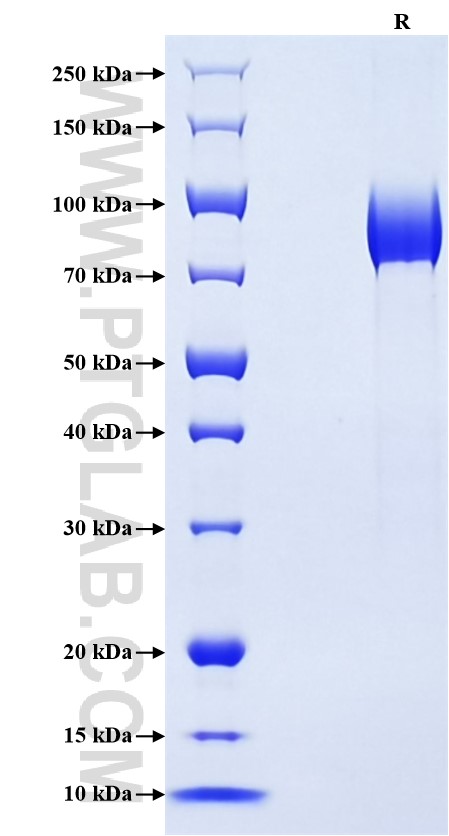Recombinant Human CD204 protein (rFc Tag)
种属
Human
纯度
>90 %, SDS-PAGE
标签
rFc Tag
生物活性
未测试
验证数据展示
产品信息
| 纯度 | >90 %, SDS-PAGE |
| 内毒素 | <0.1 EU/μg protein, LAL method |
| 生物活性 |
Not tested |
| 来源 | HEK293-derived Human CD204 protein Lys77-Leu451 (Accession# P21757-1) with a rabbit IgG Fc tag at the N-terminus. |
| 基因ID | 4481 |
| 蛋白编号 | P21757-1 |
| 预测分子量 | 68.5 kDa |
| SDS-PAGE | 75-110 kDa, reducing (R) conditions |
| 组分 | Lyophilized from 0.22 μm filtered solution in PBS, pH 7.4. Normally 5% trehalose and 5% mannitol are added as protectants before lyophilization. |
| 复溶 | Briefly centrifuge the tube before opening. Reconstitute at 0.1-0.5 mg/mL in sterile water. |
| 储存条件 |
It is recommended that the protein be aliquoted for optimal storage. Avoid repeated freeze-thaw cycles.
|
| 运输条件 | The product is shipped at ambient temperature. Upon receipt, store it immediately at the recommended temperature. |
背景信息
MSR1 also known as CD204, belongs to the scavenger receptor family, which is mainly expressed on the surface of macrophages. MSR1 plays a key inflammatory role in various pathophysiological processes, including atherosclerosis, innate and adaptive immunity, lung and liver disease, and cancer. MSR1 binds to a variety of ligands, including modified low-density lipoproteins (LDL) and lipids, and is involved in endocytosis, positive regulation of cholesterol storage, and positive regulation of macrophage-derived foam cell differentiation. Studies have shown that MSR1 is significantly increased in peripheral blood mononuclear cells (PBMCs) from patients with asthma and chronic obstructive pulmonary disease (COPD), which may serve as a disease marker.
参考文献:
1. Olivier Govaere, et al. (2022) J Hepatol. 76(5):1001-1012. 2. Jack Gudgeon, et al. (2022) Front Immunol. 13:1012002. 3. Selene Baos, et al. (2022) J Clin Med. 11(5):1439.
